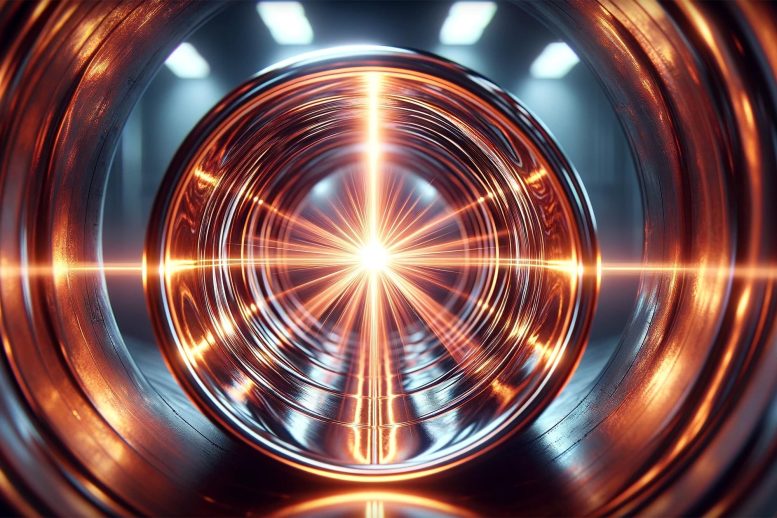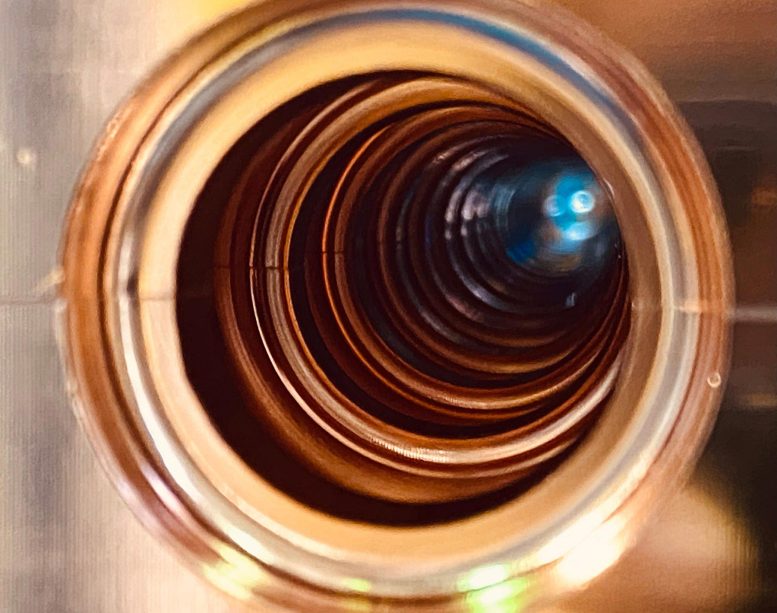
The Cool Copper Collider (C3) represents a shift towards sustainable particle physics, with a design that could halve energy consumption and a construction process aimed at reducing the carbon footprint of collider projects.
The future of experimental particle physics is exciting – and energy intensive. SLAC physicists are thinking about how to make one proposal, the Cool Copper Collider, more sustainable.
Ever since the discovery of the Higgs boson in 2012, physicists have wanted to build new particle colliders to better understand the properties of that elusive particle and probe elementary particle physics at ever-higher energy scales.
The trick is, doing so takes energy – a lot of it. A typical collider takes hundreds of megawatts – the equivalent of tens of millions of modern lightbulbs – to operate. That’s to say nothing of the energy it takes to build the devices, and it all adds up to one thing: A lot of carbon dioxide and other greenhouse gases.
Innovating Energy Efficiency in Collider Design
Now, researchers from the Department of Energy’s SLAC National Accelerator Laboratory and Stanford University have thought through how to make one proposal, the Cool Copper Collider (C3), more energy efficient.
To understand how to do so, they considered three key aspects that apply to any accelerator design: how scientists would operate the collider, how the collider itself is built in the first place and even where the collider is built – which turns out to have a significant, if indirect, impact on the project’s overall carbon footprint.

A section of the proposed Cool Copper Collider beam tunnel. Credit: Emilio Nanni/SLAC National Accelerator Laboratory
“When discussing big science, it’s mandatory now to think not only in terms of financial costs, but also environmental impact,” said Caterina Vernieri, an assistant professor at SLAC and one of the co-authors of the new paper, which was published in PRX Energy.
Emilio Nanni, an assistant professor at SLAC and another co-author, agreed. “As scientists we all hope to inspire the public and future generations not only through our discoveries, but also through our actions,” Nanni said. “This requires that we consider both the potential scientific impact and the overall impact on our community.” Making facilities more sustainable, he said, will help achieve both goals.
Collider Design Variations and Environmental Impact
C3 is one of a number of different proposals for a next-generation accelerator capable of probing the Higgs and beyond, although they all follow one of two basic designs: linear accelerators, such as C3 and the proposed International Linear Collider, and synchrotrons, or future circular accelerators, such as the Future Circular Collider or the Circular Electron Positron Collider.
Each has their advantages and disadvantages. Notably, synchrotrons can re-circulate particle beams, meaning they can collect data over many loops. However, they hit a limit, because charged particles like protons and electrons lose energy when their paths are bent into a circle, driving up power consumption. Linear accelerators don’t have the energy loss problem allowing them to achieve higher energy and open up the possibility for new measurements, but they use the beam only once and to achieve higher data rates they need to work with intense beams.
C3 aims to solve the length-versus-energy limitations of most linear accelerators with a new design, including more precisely tailored electromagnetic fields fed into the accelerator at more points as well as a new cryogenic cooling system. The project also aims to use more interchangeable parts and a construction approach that could significantly lower costs, ultimately resulting in a relatively low-cost and small collider – as short as about five miles – that could nonetheless probe the extreme frontiers of particle physics.
Making Big Physics More Sustainable
Still, the proposed C3 collider would take a lot of resources to build and operate, so its proponents addressed a growing concern by taking the carbon footprint of major physics projects into account, starting with how they would operate the accelerator itself.
Historically, physicists did not pay much attention to how they operated accelerators, at least in terms of energy efficiency. The SLAC and Stanford team found, however, that subtle changes, such as changing the structure of the particle beam and making improvements in the operation of klystrons, which create the electromagnetic fields that drive the beam, could make a difference. Taken together, these improvements could cut C3‘s power needs from around 150 megawatts to perhaps 77 megawatts, or nearly in half. “I would happy with 50% of that,” Vernieri said.
On the other hand, the team found, construction itself is likely to be responsible for the bulk of the carbon footprint for C3– especially as the world shifts to using more renewable energy. The researchers suggest that using different materials, such as different forms of concrete, as well as attending to how materials are manufactured and transported, could help lower the global warming impact. C3 is also significantly smaller than other accelerator proposals – only eight kilometers long – which would reduce the overall use of materials and allow builders to select sites that could simplify and speed up construction.
The researchers also considered where the C3 project would be located, since that could affect the mix of fossil-fuel versus renewable energy that powered the collider, or potentially building a dedicated solar farm that would, along with an energy storage system, cover the accelerator’s needs.
Comparative Sustainability of Future Colliders
Finally, the SLAC-Stanford team looked at how C3 might compare with other future collider proposals, as well as how linear and circular colliders compare, when each collider performs similar measurements.
Based on their analysis and similar sustainability studies for other accelerators, the team found that construction is likely to be the main driver of a project’s carbon footprint, but that circular colliders capable of similar physics goals would generally have higher emissions related to construction. Likewise, shorter accelerators such as C3 and another proposal, the Compact Linear Collider, would have less global warming potential compared to longer ones.
“It’s so new as a field,” Vernieri said of studying the sustainability of physics projects, but a necessary one. “There is a whole new discussion at least posing the question of the carbon footprint of particle physics.”
Reference: “Sustainability Strategy for the Cool Copper Collider” by Martin Breidenbach, Brendon Bullard, Emilio Alessandro Nanni, Dimitrios Ntounis and Caterina Vernieri, 26 October 2023, PRX Energy.
DOI: 10.1103/PRXEnergy.2.047001









… One think I know is that humankind has a very slow advances, and then comes war and then it becomes even more slow…
… One interesting thing is a steam machines. Tha ones that could be discovered by old Greeks… but… no luck there…
… Or one interesting thing thought by Tesla. Tha almost could create flying saucers… just if it could use Tesla valve for that in electrical way.;. Ah, Yah… it could figure out one nice puzzle, but it couldn’t figure our how genius the solution really was…
It looks like humans will stay humans…